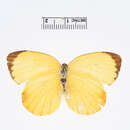en
names in breadcrumbs


Eurema es un género de mariposas de la familia Pieridae.[3] Se encuentran en Asia, África, Australia, Oceanía y el nuevo mundo.
La especie tipo es Papilio delia Cramer, 1780, según designación posterior realizada por Butler en 1870.[4][2]
Existen 58 especies reconocidas en el género, 19 de ellas tienen distribución neotropical.[5]Al menos 12 especies se han reportado en la región neártica,[6] y 9 de ellas tienen distribución afrotropical.[7]
Las especies del género Eurema se alimentan de plantas de las familias Fabaceae, Rhamnaceae, Violaceae, Apocynaceae, Theaceae, Euphorbiaceae, Clusiaceae, Cucurbitaceae, Arecaceae, Rubiaceae, Osmundaceae, Santalaceae, Asteraceae, Verbenaceae, Simaroubaceae, Hypericaceae y Brassicaceae. Las plantas hospederas reportadas incluyen los géneros Adenanthera, Astragalus, Caesalpinia, Cassia, Paraserianthes, Parkinsonia, Senna, Albizia, Entada, Ormocarpum, Pithecellobium, Ventilago, Acacia, Acrocarpus, Agatea, Alstonia, Camellia, Delonix, Gleditsia, Gliricidia, Moullava, Ormosia, Sesbania, Xylia, Breynia, Chamaecrista, Desmodium, Hypericum, Tephrosia, Aeschynomene, Arachis, Glycine, Medicago, Mimosa, Stylosanthes, Trifolium, Calliandra, Zornia, Galactia, Rhamnus, Desmanthus, Leucaena, Abrus, Berchemia, Bridelia, Bryonia, Cocos, Coffea, Cratoxylum, Dichrostachys, Indigofera, Kummerowia, Lespedeza, Lotus, Osmunda, Parkia, Phyllanthus, Pterocarpus, Robinia, Sageretia, Santalum, Smithia, Solidago, Tectona, Trigonella, Ziziphus, Neptunia, Brassica, Diphysa, Machaerium.[8][9][10][11][12][13][14][15]
Eurema es un género de mariposas de la familia Pieridae. Se encuentran en Asia, África, Australia, Oceanía y el nuevo mundo.
Terias er en slekt av sommerfugler i gruppen hvitvinger.
Små til middelsstore (vingespenn ca. 32-48 millimeter), mer eller mindre gule, bredvingede sommerfugler. Spissen av forvingen er vanligvis mørk, og underside har vage, brune tegninger. Sjeldnere har de mer omfattende, svarte tegninger, eller oversiden er helt brun.
Disse sommerfuglene finnes gjerne på gressmark og i åpen skog, også ved dyrket mark og i hager. De fleste artene har larver på busker og trær i erteblomstfamilien, noen nytter også planter i perikumfamilien. Larvene til den vidt utbredte Terias hecabe kan utnytte en rekke ulike fødeplanter.
Slekten er utbredt i Sørøst-Asia, Australia og Afrika. Mange arter, for eksempel Terias hecabe, har svært vid utbredelse.
Slektskapsforholdene mellom hvitvingenes delgrupper og slekter kan være avklart i ulik grad. Derfor kan endringer skje. Artene i denne slekten blir ofte ført til Eurema.
Terias er en slekt av sommerfugler i gruppen hvitvinger.